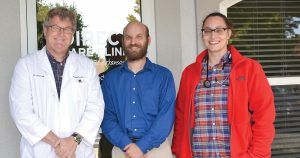Unique doctor-patient relationships helping to grow direct primary care
by November 21, 2017 4:53 pm 1,432 views

Dr. Dan Weeden likes caring for the whole family – from babies all the way to grandmas. He spends time building relationships with them, much like doctors did 50 years ago when they knew and cared for whole families from birth.
So, when Mercy Hospital came to Weeden – after he had been practicing medicine for them for about 20 years – and told him they were going to increase his patient load two to three times above his 2,225 patients, and that he would only see the most critically ill patients because he would have two or three nurse practitioners working for him, Weeden knew that wasn’t the way he wanted to finish his career.
“I wanted to take the time to address what was going on with [patients] and that couldn’t happen in a 10-minute appointment,” he said. “I found that in 10 minutes you could identify ‘Yes, that’s the problem.’ But if you ask the right questions, if you open that door, the tears were going to flow and you were going to get 30 minutes behind — and you were already 45 minutes behind — and so you just stopped asking. You just sort of put Band-Aids on. I just felt like I was putting Band-Aids on.”
Dr. Joel Fankhauser, a colleague of Weeden’s, who had been practicing family medicine at Mercy for about four years, felt the same way.
“There’s a lot that gets missed when you’re trying to cram a visit into six minutes of face time,” he said. “Increased actual time with patients allows you to figure out what really might be their underlying problem. It allows us to form a real doctor-patient relationship and trust gets built between us.”
Weeden and Fankhauser then began researching a totally different way to run a doctor’s office, called direct primary care. Direct primary care (DPC) is a small nationwide movement by internists, family-medicine physicians and pediatricians that bypasses insurance and charges patients a monthly fee — typically less than $100 — for a range of primary care services. Doctors have fewer patients and don’t have to spend time doing paperwork to satisfy insurance companies. The result is being able to spend more time with each patient. That, in turn, they believe improves the quality of care.
According to 2015 survey data from the American Academy of Family Physicians (AAFP), about 3% of family physicians nationwide have DPC practices. The AAFP supports DPC and encourages established physicians and those just finishing residency to consider it.
“We are starting to see early data that DPC can actually improve patient outcomes, definitely improves patient satisfaction and definitely improves the satisfaction of providers in the system, and does so at a lower cost,” Dr. Reid Blackwelder, AAFP board chair, said.

Although DPC is similar to concierge medicine since doctors have fewer patients, there are major differences. Unlike DPC, concierge practices file insurance and usually cater to wealthy patients, and so are more expensive.
‘PEACE OF MIND’
In January 2015, Weeden and Fankhauser opened the Direct Care Clinic of Northwest Arkansas in Rogers. In June this year, they added a third doctor, Dr. Lynn Davis.
Mike and Amie Armstrong and their four children, ages 11 to 19, were patients of Dr. Fankhauser’s at Mercy and followed him to the new clinic. The total monthly fee for their family is $160, which provides acute and preventative care and 24/7 access to the doctors. Fees for individuals range from $40 to $80 per month, depending on age.
With two children who have Type 1 diabetes, Armstrong likes the near constant access she has to Dr. Fankhauser through email, text, FaceTime and phone calls.
“There’s a peace of mind that comes from knowing if you have an emergency situation, you are able to reach an actual, live doctor, pretty much any time you need to,” she said.
Armstrong said her family’s membership at the clinic has saved them money by being able to talk to a doctor instead of going to the emergency room.
“Having a family of six, it seems like something is always happening,” she explained. “They’ve saved us at least two trips to the emergency room. They were able to talk with my husband after he injured his ankle with fireworks over the 4th of July… to FaceTime over our iPads and assess the situation and get a prescription for the medicine that night.”
“Another Saturday night we had a child with a spider bite, and we were able to FaceTime,” she said. “Just being able to provide that immediacy is a huge benefit for us.”
Armstrong believes her family saves money by using the clinic, but added, “I’ll tell you, even if it balanced out to be totally even, or even if we were having to pay a little bit more, I would still do it,” she said. “I would give up a lot before I gave up this particular service.”
A NICHE FOR THE UNINSURED
Weeden said that, while the doctors encourage people to have insurance for major health events, they don’t believe it is necessary for basic primary care.
“What we do is routine, it’s predictable, and there’s nothing about it that needs to be insured,” he said. “You insure something you can’t afford, that’s unpredictable, that’s catastrophic,” he said.
Dr. John Furlow, who opened his direct care clinic in Fayetteville four years ago, said health care insurance should be more like car insurance —only used for major expenses.
“If you have automobile insurance, you hope you never use it, but you don’t use your automobile insurance for a tire rotation or oil change or gas,” he said.
Weeden said he believes his clinic especially benefits people without insurance, those who self-insure (like small businesses) and those with high deductibles. Patients save money with direct care because routine labs are cheap, quick access to a doctor means fewer trips to the emergency room and all visits are included for patients with chronic conditions who see the doctor a lot.
“The other group who saves money are those with high deductible plans,” Weeden said. “They never meet their deductible in a year. If you go to my old clinic … you’re paying $80 until you meet your deductible. And, if your deductible is $6,000, you just don’t meet that.
“So you’re going to be paying that every time you go to the doctor and if you go five times in a year, we’re probably a little cheaper.”
INVALUABLE ACCESS
Weeden and Furlow believe DPC will grow, because young physicians establishing practices after residency will embrace it.
“I think in the long run, this could attract new guys that want to be primary care doctors,” Weeden said. “Because I think younger people are looking more for time and lifestyle — not just how much money you make. And that’s one thing this practice really affords.”
Furlow also believes millennial generation patients who are more open to change, want more personalized care and don’t want to pay huge insurance premiums will be attracted to the model.
Pending legislation in Congress also promises to make DPCs more accessible. HR 365, the Primary Care Enhancement Act, will enable individuals to pay their monthly DPC fees out of their Health Savings Account, so the fee would be tax deductible.
A patient who has been under Weeden’s care for 10 years, but who asked not be identified, was recently diagnosed with breast cancer. She said it doesn’t matter to her that Weeden’s monthly fee is not covered by insurance. Weeden coordinated her care during the major health event, and that was invaluable to her.
“Having him as the quarterback, he’s just worth his weight in gold,” she said. “You know when you are in his care, he’s going to navigate you through it, and he’s really good at it. He has the networks and the doctors that he helps you with, he coordinates things to get second opinions.”
Because he has fewer patients, Weeden can go with his patients to see a specialist. For instance, if he has a patient with cancer, he can go to their appointment at Highlands Oncology, and even exchange phone numbers with the doctor there.
Weeden’s patient said since she and her husband are retired and travel a lot, there is great security in knowing no matter where they are in the country, they can keep in touch with him by phone or text to ask medical questions, or get a prescription.
“We call the office, and they know us. I mean they know our bodies and what medications we do well with and don’t do well with … it goes beyond confidence,” she said. “It’s a safety net.”
Furlow describes it as “old-fashioned medicine made new.”
“We are using technology to communicate with our patients to provide the old-fashioned service of the old family doctor who used to have his bag and come to your house and provide [your care],” he said.
